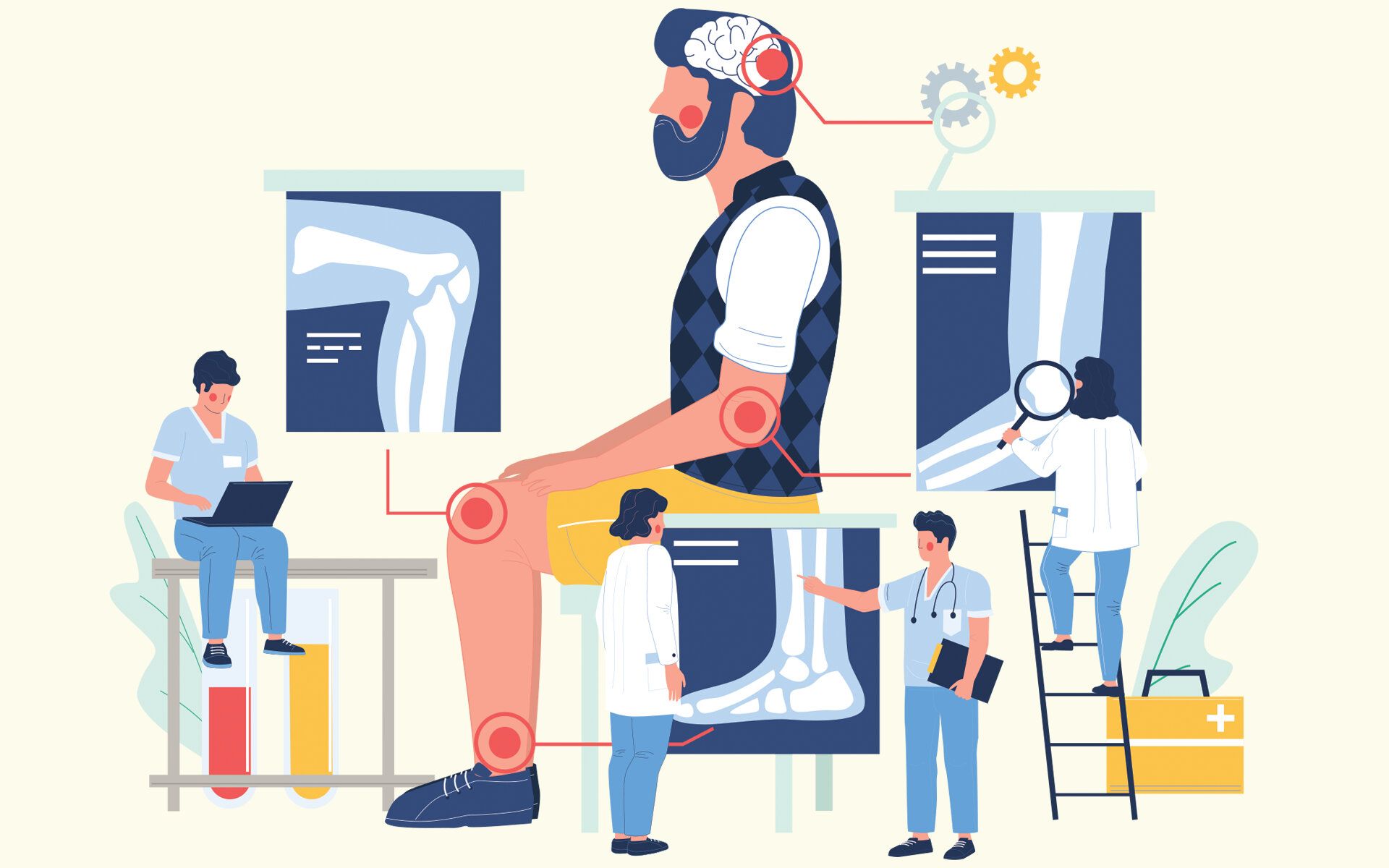We Feel Pain

In This Article
-
We feel the sense of pain as bad and a nuisance, but in fact it is a great blessing.
-
Every pain is unique to each individual and a treatment may be good for one person while it may not be effective in another person.
-
The Earth is a pharmacy created with a remedy for every illness.
How would life be if we never felt any pain? If your answer to this question is "great" then you know nothing about the consequences of "congenital analgesia," a condition in which a person cannot feel physical pain from external stimulants since birth. People with this condition cannot react to external damage and may even injure themselves without noticing. We feel the sense of pain as bad and a nuisance, but the fact that it is a great blessing is perhaps what is alluded in the Qur’anic verse, "It may well be that you dislike a thing, but it is good for you, and it may well be that you like a thing, but it is bad for you," (2: 216). Indeed, pain is a mechanism assigned with an important task to inform us of failing parts of our body even though it appears to have an adverse effect on our daily routines. This ensures us that we give proper reactions and prevent additional damage.
Definition and types of pain
The International Association for the Study of Pain defines pain as "an unpleasant sensory and emotional experience associated with, or resembling that associated with, actual or potential tissue damage." With the advent of "algology" or the "study of pain" a long list of terms has been generated. People feel pain when certain nerves, called nociceptors (receptors that respond to stimuli threatening body tissue or existing injury), detect tissue damage and send a signal concerning the damage along the spinal cord to the brain. For instance, if you touch a hot surface a reflex in the spinal cord will send a signal thus causing muscles to contract immediately. This contraction will move the hand away from the hot surface and prevent further damage. This reflex process is so fast that the signal does not reach the brain by the instant we take the action. The signal for pain, however, continues to be sent to the brain. The brain's interpretation of these signals, and the effectiveness of communication routes between nociceptors and the brain determine how an individual experiences their pain. The brain also triggers the secretion of certain chemicals like dopamine against unpleasant effects of the pain [1]. There are several criteria used in differentiating different types of pain:
Types of pain depending on how they start:
- Acute pain: Such pains are generally intense and brief. These pains warn an individual about injury or local tissue damage. Treating the injury or damage will normally eliminate such pains. There are different types of acute pain; somatic pain (resulting from inflammation); visceral pain (related to the stomach, kidneys, gallbladder, or other organs); and referred pain (such as experiencing shoulder pain during a heart attack).
- Chronic pain: This type of pain can last longer than acute pain and usually cannot be treated. Chronic pain may be mild or severe. It may be continuous as is often the case with arthritis (inflammatory pains) or intermittent as with migraine [2].
Types of pain depending on their mechanisms:
- Nociceptive pain starts upon stimulation of nociceptors and ends with treatment. There are also pains such as arthralgia (lower back pain) pain resulting from sports injuries, or surgical operations.
- Neuropathic pain: These can feel similar to electric shocks or may result in tenderness, numbness, or tingling. It occurs upon damage to nerves of the nervous system as well as in rheumatic diseases and fractures, dislocation, or injury inside muscles.
Types of pain depending on location:
- Somatic pain: It results from inflammation, recurring traumas, excessive physical activity, strain, and excessive stretching. Somatic pain increases with activity and decreases and end upon rest.
- Visceral pain: It is the widespread pain that occurs upon damage or injury to internal organs. It results from problems in organs like the stomach, kidneys, gallbladder, or urinary bladder.
- Peripheral pain: It may originate in muscles, tendons or directly from peripheral nerves.
Diagnosing pain
There are various ways to feel pain or ache and so are various ways to describe it. Some conditions make it harder to define and treat pain. Variations in pain threshold (the lowest limit of intensity of stimuli) may complicate diagnosis and treatment while pain tolerance (the highest level of pain one can stand) may also affect the diagnosis. There is no objective scale for identifying the type of pain. However, the characteristics of one’s pain, such as burning, stinging, or stabbing, as well as the site, frequency, and radiation of pain and what it feels like are important. The factors aggravating or relieving the pain, and the times at which pain occurs during the day, facilitate diagnosis. There are several systems to identify and grade pain. However, the most important factor in correctly diagnosing the pain is to ensure the clear communication between the individual and the physician [3].
Treating pain
Every pain is unique to each individual and a treatment may be good for one person while it may not be effective in another person. Acute pains are generally treated with medication. Such pains usually stem from an underlying health problem and when this problem is treated, pains go away. For instance, a pain caused by a bacterial infection can be relieved by treating the infection with antibiotics. All options for medication should be discussed carefully with the physician and extensive explanation should be provided. In the treatment of chronic pain, on the other hand, nondrug therapies may help mitigate pain. These therapies include acupuncture, nerve blocks, psychotherapy, surgical operation, biofeedback (a mind-body technique in which people can learn to control their organs and automatic processes, such as their heart rate, with their thoughts more effectively), relaxation therapies, and sujok therapy (treatment in which pressure points in hands and feet are stimulated) [4]. Using volatile oils, herbs, and certain spices as natural painkillers is another option. Lavender essential oil may help relieve pain naturally. It may be used as a painkiller or in order to get better sleep and reduce anxiety [5]. Rosemary oil helps relieve pain. Research has shown that the rosemary plant (Rosmarinus officinalis L.) can be beneficial in treating headaches, muscle, and bone aches [6]. Diluted peppermint oil (Mentha piperita L.) and eucalyptus (Eucalyptus) can be used for treatment by rubbing painful or sore parts of the body with them [7]. Capsaicin is an agent used in topical creams and plaster for pain management and most analgesic products contain this agent. This agent is abundant in chili pepper and therefore the usage of this spice is a preferred natural method for pain management. The use of ginger, turmeric, and daisy (Tanacetum parthenium) to treat migraines, abdominal pain, and muscle pain is common [8].
In the eyes of believers, the Earth is a pharmacy created with a remedy for every illness. Yet, all these remedies are only causes and their effectiveness is dependent on the One who willed them to be available in the first place. Believers also know that, like other tribulations in this life, pains with known or unknown names can be seen as a sort of test for our perfection in faith or as atonement of our sins. Prophet Muhammad, peace and blessings be upon him, said, "No calamity befalls a believer but that God expiates some of his sins because of it, even though it were the prick he receives from a thorn" [9].
"Make use of medical treatment, for Allah has not made a disease without appointing a remedy for it, with the exception of one disease, namely old age." (Abu Dawud).
References
- http://www.iasp-pain.org/Education/Content.aspx?ItemNumber=1698#Pain
- http://www.aans.org/Patients/Neurosurgical-Conditions-and-Treatments/Chronic-Pain
- https://www.medicalnewstoday.com/articles/145750#causes
- https://onlinelibrary.wiley.com/doi/10.1002/acr2.11092
- Sasannejad, P., Saeedi, M., Shoeibi, A., Gorji, A., Abbasi, M., & Foroughipour, M. (2012). Lavender essential oil in the treatment of migraine headache: a placebo-controlled clinical trial. European neurology, 67(5), 288-291.
- Solhi, H., Salehi, B., Alimoradian, A., Pazouki, S., Taghizadeh, M., Saleh, A.M., & Kazemifar, A.M. (2013). Beneficial effects of Rosmarinus officinalis for treatment of opium withdrawal syndrome during addiction treatment programs: a clinical trial. Addiction & health, 5(3-4), 90.
- Ali, B., Al-Wabel, N.A., Shams, S., Ahamad, A., Khan, A.S., & Anwar, F. Review article essential oils used in aromatherapy: a systemic review. Asian Packag J Trop Biomed. 2015; 5 (8): 601–11. This review enumerates the various oils used by people who do aromatherapy.
- https://www.medicalnewstoday.com/search?q=natural%20painkillers
- Bukhari, Marda 1; Muslim, Birr 52, (2573); Tirmidhi, Janaiz 1, (966).









